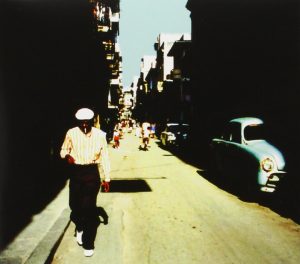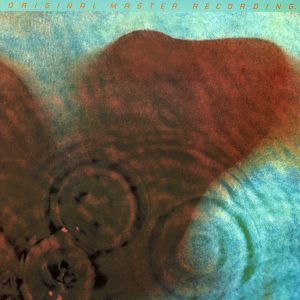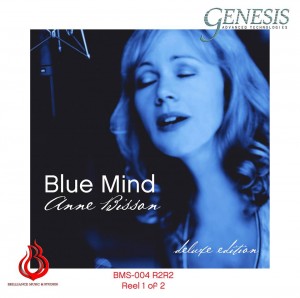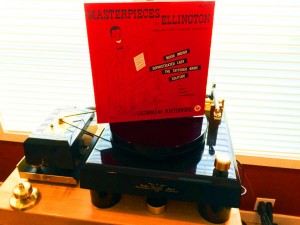The history of the Krakow Sonic Society meetings with various types of Compact Discs is quite long. Almost as long as the list of technical studies intended to improve the process of reading signal from these discs. Already in May 2009, as part of the 64th KSS, we discussed new (for us) patents of EMI Music Japan, i.e. HiQualityCD (HQCD) and Sony Music Japan, i.e. Blu-Spec CD. Both, together with the Universal Music and JVC patent—the SHM-CD—were launched in 2008.
In July 2013 (meeting 89) we looked at all these proposals, along with K2 HD and XRCD discs. Later we also talked about XRCD, MQA-UHQCD and Platinum SHM-CD. Finally, in December 2018, I prepared a cross-sectional article entitled COMPACT DISC - obviously! But what kind?, in which I tried to present differences between various types of CDs. So it seems that we've looked at almost all of them.
The presentation that I witnessed during the High End Show 2019 in Munich, prepared by the Memory-Tech company, reminded me that we haven't really discussed the latest version of CD proposed by this Japanese specialist, the Ultimate HQCD. And maybe I could give it a rest, after all there are many other topics that are asking for our attention, if not for what I heard there.
Ultimate Hi Quality CD
On April 17th 2015 Memory Tech on its website released following information:
We would like to announce a new high quality Compact Disc type, the "UHQCD (Ultimate Hi Quality CD)." UHQCD is a new standard by newly developed process to reproduce the faithful sound more master than conventional high-quality disk.
memory-tech.co.jp, accessed: 17.07.2019
With this step, the Memory-Tech referred to the newer Blu-spec CD version of Sony, i.e. BSCD2 announced in September 2012, and Platinum SHM-CD from Universal Music and JVC from September 2013. It was the UHQCD (Ultimate Hi Quality CD; with optional spelling Ultimate HiQualityCD or Ultimate HQCD). The corrections introduced by both competitors were important, but more cosmetic than groundbreaking, because the solutions used in the original versions have passed the test of time.
It was different with the Ultimate HQCD—compared to HQCD they introduced far-reaching—and expensive!—changes. Let me remind you that the novelty in HQCD was primarily the material from which the disc was made. In a classic CD it is polycarbonate, a type of plastic, spread on a metal matrix by a fast rotary motion. Its advantage is low cost and speed of replication—the material hardens almost immediately.
However, the speed in question is a problem. The plastic hardens so quickly that it cannot fill the pits of the matrix accurately. Even more problematic are the uneven transitions between pitas and lands - and it is at the transitions that the logical state changes from "0" to "1" and vice versa. As the measurements show, it is a big problem for a reading system, which must work harder, and thus generates a higher level of jitter.
Memory-Tech then developed a process in which instead of polycarbonate it used a different type of plastic used to produce precision LCD displays. It corrected errors of the classic material because it was more fluid, and thus better filled cavities, and also gave better transitions between pits and lands. Even more important was that this material turns solid under UV light, and not by cooling, which makes it possible to calculate very precisely when it should be solidified. This extended the production process, but the measurable results were excellent.
Although we didn't know that, Memory-Tech was already working on an even better technique. The solution to the problem in question has been known in the industry for years. It's just that it was reserved for professional activities, such as testing and calibrating factory reading systems, as well as a benchmark for calibrating CD-ROM drives for industry. For these activities, Memory-Tech made individual calibration glass discs using machines developed for the Laser Disc technique.
A fluid material was applied to the metal matrix, pressed with a crystal glass plate. After pressing, the material was irradiated with UV rays and then solidified. After separation from the matrix, a gold layer was applied to the plastic layer. This is a very expensive technique, but it was decided that it was worth offering it to customers. This is how Crystal Disc discs were created, costing between PLN 6,000 and 8,000 per item.
Ultimate HQCD benefits from this solution directly, though without reaching for the glass plate. The beginning is the same as in Crystal Disc: a photosensitive polymer, UV-solidified, is applied to the metal matrix. And only on top classic polycarbonate is applied, adding rigidity to the disc. As a result a disc with much lower jitter than regular CD is obtained. The difference is shown both by measurements and listening tests—because in this way the manufacturer checks his solutions. You will learn more about this technique from the movie The secret of UHQCD , prepared by Memory-Tech.
HOW WE LISTENED TO IT
I admit that I am a fan of the Japanese approach to audio—both in its vintage edition and high-tech. This is the only country where these two exist in parallel, supporting each other rather than fighting each other. Thanks to this, we get, on the one hand, Kondo and Leben amplifiers, use NOS tubes and cables, and on the other we play music using SPEC amplifiers and from Platinum SHM-CD, BSCD2 and Ultimate HQCD.
The listening session I prepared was based on two samplers: the Ultimate HQCD Series Highlights (Warner Classics WPCR-136633) available to the public and Feel the Difference. UHQ CD vs Standard CD (Memory-Tech UHQCD-SAMPLE2) that I got from Mr. Hiroshi Ihar, head of the Memory-Tech sales department in Munich. In both cases, identical material was pressed on two discs: a classic CD and an Ultimate HQCD. A separate listening session was devoted to comparisons between HQCD and SACD discs—to "calibrate" and recall the sound of HQCD—and finally we listened to the comparison between UHQCD and CD:
- Herbie Hancock, Maiden Voyage, Blue Note/EMI Music Japan TOCJ-90039, HQCD (1965/2008)
- Herbie Hancock, Maiden Voyage, Blue Note/Universal Music LLC UCGQ-9009, SHM-SACD (1965/2017)
- HQCD JAZZ Selection, EMI Music Japan TOCJ-90010, CD + HQCD (2009)
- Fusion. Best Sound Selection, sel. Yoshiro Obara, Stereo Sound SSRR-12, "Stereo Sound Reference Records," SACD/CD (2019)
- Native Son, Native Son, Victor Entertainment VICJ-77016, K2HD Pro Mastering, Ultimate HQCD (1979/2016)
- Radiohead, OK Computer. OKNOTOK Edition, XL Recordings/Beat Records XLCDJP868, 2 x Ultimate HiQuality CD (1997/2017)
- Radiohead, The Best of, Parlophone EMI Records 5099922758828, 2 x CD (2008)
And another interesting fact—the logo and the name Ultimate HQCD (UHQCD, Ultimate HiQualityCD) can be found on the Warner Music group discs. But the patent for the logo and for this technique are the property of Memory-Tech. This type of discs will also be released with logos of other labels, for example Nippon Columbia (Denon), but on the cover we will find a fairly simple UHQ CD logo.
SOUND
HQCD vs SHM-SACD
- Herbie Hancock, Maiden Voyage
We listened to the first disc using it as a way to calibrate our hearing. We listened to one of the first HQCD releases and a new DSD transfer from 2017 from a SHM-SACD.
Tomek | When I listened to the HQCD, it seemed to me that something was wrong with this recording—it was somehow unpleasant at first. But—to be clear—it didn't sound too good with SACD either. With SACD, the sound was definitely darker and more natural. However, I think that this is not a good recording in itself, so it wasn't a good sounding one in either version. So the differences didn't matter much to me.
Marcin | I agree with Tomek—SACD sounded better, but still not very good. In the first version, i.e. with HQCD it was very bad, and with SACD only bad. But it was a matter of some part of the band, that made me feel as if something was resonating in my ears. Maybe we just played it too loudly.
Wiciu | The HQCD version sounded more aggressive and I did not like the first sounds from the piano and cymbals—they were distorted. With SACD the same fragments seemed smoother, quieter to me. The cymbals sounded better. But it wasn't spectacular enough for SACD.
Janusz | My two cents; first of all, a word about the recording. It was one of my first jazz albums. In the 1970s I was crazy about it. But I was terrified of how bad this album sounded. Blue Note discs from the 1960s sound many times better, and the Maiden Voyage—one of the best jazz albums in general—is tragically bad recorded. Secondly, I can hear what SACD brings, because now I listen only to this type of discs, and I have to say that the SACD version sounded better.
Bartosz | I agree with Tomek and Marcin and Janusz—the sound quality was hopeless. I was a bit afraid that I would sound foolish because I was a bit prejudiced against Hancock—his concert in Krakow, in the ICE hall, was probably the worst concert I've ever been to. It was a bad musical experience, and even worse in terms of sound quality.
Tomek | Because you didn't go to Diana Krall at Tauron Arena…
Marcin | The sound was really good, I sat directly in front of her in the sixth row on the balcony. I was only surprised by the low volume level.
Tomek | They played so quietly because the sibilants were hovering around the hall so much that if they played a bit louder, everybody would have left. I was sitting downstairs on the ground level, in the thirteenth row. After the first song, as Krall coughed, I knew there was something wrong. I read on the internet that she was sick, but I didn't know it was that bad. After the third song she joked about the drinking vodka in the evening that could cure her, but she barely lived.
Bartosz | To finish up my thought—I was afraid you'd take me for a hater, and additionally I simply don't like this album. But I can see I'm not alone in my assessment—if I had to chose one version it would be the SACD. HQCD was annoying and too loud.
CD vs Ultimate HQCD
- Ultimate HQCD Series Highlights
During the second part we perform a blind test listening to the same track twice. We used:
- ANTON BRUCKNER, Symphony No.7 in E Major (Nowak Edition), Allegro Moderato (Fade Out), perf.. Franz Welser-Most
- IGOR STRAVINSKY, The Firebird – Suite (1919), Finale, perf. Carlo Maria Giulini
The FIRST track was from CD, the SECOND from Ultimate HQCD. The listeners found out which was with after they assessed both versions so whenever they refer to no, one or first they mean CD, the two or second means Ultimate HQCD.
- ANTON BRUCKNER, Symphony No.7 in E Major (Nowak Edition), Allegro Moderato (Fade Out),
Tomek | The first version we listened to was definitely better. The other one was more dim, bland and I didn't like it.
Marcin | In my opinion the first version sounded darker, richer, there was more going on in it. The second one sound "light," so to speak, bland—I didn't like it.
Wiciu | This is quite an old recording and the cellos seem distorted to me, in both cases. The difference is minimal for me. But if I had to choose, I would choose the second one. It is less aggressive and therefore better.
Rysiek B. | This is a bit about the recording philosophy. If we think that the recordings should sound "studio-like," this is how the first version sounded. However, if you refer it to live concerts, the second version is definitely closer to what you live—and I think I liked it better. This is a concert recording anyway. That's how I would hear it sitting in a good spot and listening to a good orchestra. It's a matter of taste: do we want to have the sound from a studio, or the impression of listening to music in a real concert hall.
Tomek | But that would confirm that we should not go to classical concerts because recordings sound better.
Janusz | No doubts, the first one was better.
Bartosz | I agree—number one.
- IGOR STRAVINSKY, The Firebird – Suite (1919), Finale, perf. Carlo Maria Giulini
Tomek | I can repeat myself—I choose the first version, even though I have no idea what we are listening to.
Marcin | I also liked the first version better. Although… The second version is more lively than before. But still the first version was better because it was richer, more massive.
Wiciu | This time I also prefer the first version, because the second one was more aggressive.
Rysiek B. | Now I know for sure that I prefer the second version. The instruments breathed, there was nice space, layers, I didn't feel like all instruments played in my face, forward, without differentiation of actual positions on the stage. I wouldn't like to listen to the fist version at home.
Janusz | Number two.
Wojciech Pacuła | OK, but elaborate please.
Janusz | I heard it really strongly now—I perceived the second version same way as SACDs—less aggressive and, interestingly, more spacial. I can't really say why. At first I thought that the number one sounded better. With each beat, however, I had the impression that my sensitivity was shifting, that the second version sounded better and better. And there is nothing to discuss - the difference is very big.
Bartosz | I liked the number one better. The second version for me was more aggressive, so I obviously heard it differently than Janusz.
CD vs Ultimate HQCD
- Feel the Difference. UHQ CD vs Standard CD
Again it was a "blind" comparison. This time FIRSTLY we played music from Ultimate HQCD, and SECONDLY from a CD. The listeners found out which was with after they assessed both versions so whenever they refer to no, one or first they mean Ultimate HQCD, the two or second means CD.
Janusz | One! Definitely!
Rysiek B. | Two, no doubts. The presentation was musical, spatial, airy—it was a true music. The first version offered just hi-fi, simply unbearable.
Wiciu | I agree with Rysiek. I even wondered for a while whether both used the same mastering, but we know in both cases they used exactly the same material—the second version was wider and deeper.
Marcin | I also liked the second one better. It was deeper, the orchestra was bigger. The first version sounded as if they played using instruments for kids.
Tomek | For me the difference was minimal. But I was to say something it would be exactly opposite to what Rysiek said.
Bartosz | Both sounded bad, but if I had to choose I'd say: two—it sounded in a more elegant way.
CD vs Ultimate HQCD
- Radiohead, OK Computer. OKNOTOK Edition
⌈Finally, we reversed the situation from the beginning of the listening session—we listened to the new, remixed version of the Radiohead disc on the Ultimate HQCD disc and the earlier remasters of several songs from CDs. Finally, I asked everyone if they could point out any common feature in the UHQCD sound.
Janusz | First of all today I listen to Ultimate HQCD discs for the first time. For me, the UHQCD plays "wider." My impressions were similar when for the first time at home I listened to SACD disc in my system. The CD in this comparison was suppressed and compressed, and the SACD opened the sound. And that's how Ultimate HQCDs sound like. Which does not mean that it is better, but it delivers strong, big, energetic and resolving sound. These are recordings that attract attention.
Rysiek B. | I've made only one mistake. But I can say that for four sessions, I liked the Ultimate HQCD version more three times. It was more musical, gentler, more fluid, rich in colors, saturated and unrestricted.
Tomek | I would be far from drawing far-reaching conclusions as to what Wojtek asked about, that is, whether there is any common denominator for UHQCD recordings. It seems to me that there isn't one or there is but inconsistent. If someone had a disc recorded in HQCD, then they should not necessarily replace it with UHQCD, because the differences are unpredictable. It's nice that the Japanese have perfected something, but it is definitely not a breakthrough invention.
Janusz | Let me add something—if I didn't have SACD, I would definitely buy Ultimate HQCD. I would not focus on comparing UHQCD to SACD, but on comparing CD and UHQCD. And in this perspective we get something better, it is a step forward and it is a considerable one.
Marcin | I agree with Tomek. I think that there was no pattern here, there are no common elements in every recording, as is the case with Platinum SHM-CD. There were tracks that I liked more from the UHQCD and others that sounded better with SACD and CD. It depends on what the material is.
Bartosz | In my opinion, each time the CD played calmer, this is its characteristic. UHQCD sounds brighter, more aggressive. But for me, it is also a failure of this solution. When comparing Blu-spec and Platinum SHM-CDs with their CD counterparts, they almost always sounded better than CDs.
Marcin | True, you buy any Platinum SHM-CD release and be sure it will sound better than a CD.
Bartosz | That's it - if we allow the possibility that the CD version is better than something straight from Japanese laboratories, then something is wrong. But, interestingly, when we listened to the same discs at the Munich show, the difference in favor of UHQCD discs was clear. They were much more similar to Master CD-Rs with the same material—that is, to the discs from which the glass matrix was made, from which the metal matrix was created and only from which both versions were made—the UHQCD and CD.
Wiciu | No, no, I wouldn't see it that way. For me this is a great lesson—now I know that each such version needs to be listened to, because some will sound better than CDs, and others will be worse, too aggressive.
SUMMARY, or what comes of it
From the listening session from which you read the report, some interesting observations came. First of all, Ultimate HQCD does not change the sound of discs in the same way. With some, the change is positive, with others not necessarily. Secondly, the changes introduced by this solution are strong enough to polarize the recipients. Unlike all other "inventions," i.e. HQCD, Blu-spec and SHM-CD, it is worth to check before buying a UHQCD disc, whether these changes goes in a desired direction.
But there is something else there. In the article titled COMPACT DISC—obviously! But what kind? I too hastily threw HQCD and Ultimate HQCD into one bag, assuming that because they come from the same manufacturer and one technique seems to be an improved old one, the result should be similar, although slightly better. I was wrong. It turns out that UHQCDs are completely different not only from HQCD, but from all other discs.
I got the first hint in Munich—comparing UHQCDs with CD-R masters showed that they are very similar. First of all in terms of resolution. But they often sound brighter and sharper than their CD counterparts. As if the recording studios released the material slightly shifted towards the treble, slightly hardened, hoping that at the production stage, when copying a CD, the sound will warm up. It would be exactly the same as with the "lacquer" cut for the LP—"lacquer" sounds much brighter than the master tape on one side and brighter and sharper than the finished LP. And it is the mastering specialist who has to anticipate and plan these changes.
So the UHQCD is a step towards the "master" disc, and thus the master material that leaves the mastering studio. They lack the warmth and richness of SACD. But when it comes to resolution and precision, they are—next to Master CD-R, Crystal Disc and Platinum SHM-CD—master discs. But not always and not for everyone.
MEMORY-TECH CORPORATION
MADE IN JAPAN
Place: POLAND/Kraków
Text: Wojciech Pacuła
Images: Wojciech Pacuła















































